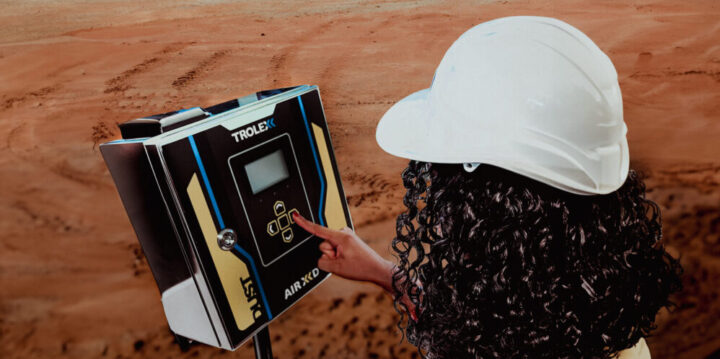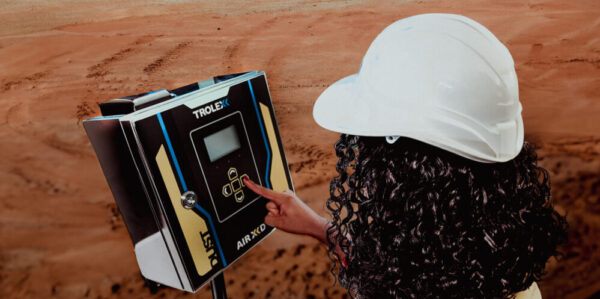Increased awareness of silicosis and other occupational lung diseases caused by exposure to hazardous levels of respirable crystalline silica has prompted employers and workers to seek ways to reduce the potential for worker exposure to hazardous dust.
This has driven a rise in the uptake of dust monitoring technologies including Remote Real-time Dust Monitoring (Fixed Point Monitoring) in workplaces across Australia.
In Australia, silicosis has been known to cause death and disability for over 100 years.
The number of Australians recently diagnosed with silicosis, particularly associated with engineered stone work, has caused government, health professionals, businesses, unions, and workers to call for safer workplaces to protect workers, reduce disability and stop premature deaths(National Silicosis Prevention Strategy 2023-2028).
Next generation dust monitoring technology is already here
Like many other industries disrupted by advances in technologies, legislative requirements and compliance regulations have not kept up with advancements in dust monitoring technology. This technology is now available in the market to reduce worker exposure to dust.
Private enterprise is carrying the mantle and pushing forward to educate the market about the improvements that can be made to worker safety to not only meet compliance requirements but to go beyond and ensure their workers are provided the best protection against exposure to dust.
The rapid re-emergence of accelerated silicosis has raised concerns about the adequacy of, and compliance with, existing work health and safety (WHS) arrangements in Australia (National Dust Disease Taskforce final report, March 2022).
Advances in the use of quality remote real-time dust monitoring units paired with real-time control management platforms like GCG’s Fixed Point Monitoring system now deliver dust control intelligence around the clock.
Fixed point monitoring of dust levels at your workplace provides a continual stream of live data. Should there be a relative change in normal workplace dust levels (based on parameters customised to your site), the system will trigger an alert in real time, allowing responsible personnel to take appropriate, informed action quickly. This allows for smarter, faster decision making to protect your workers from hazardous dust.
Is there a difference between real-time environmental monitoring and remote monitoring systems with an occupational hygiene focus?
There is sometimes confusion about the difference between environmental real-time monitoring and occupational hygiene focused real-time monitoring. Occupational hygiene focused real-time workplace monitoring looks at the workplace areas and the individual health of workers. Real-time environmental monitoring on the other hand is typically (but not always) focused on perimeter worksite boundary monitoring and looks at the exposure to dust for the community and others that may be affected by worksite operations away from work areas.
Both real-time systems use a fixed or moveable workplace monitor, an uplink system to transfer data, a dashboard that can provide real-time data feeds and data visualisation, and an alert system based on agreed dust level thresholds. The difference between the systems comes in the dashboard set-up and the focus of the data analysis.
Occupational hygiene monitoring systems and dashboards use a worker focal point, overseen by an occupational hygienist – meaning the dust measurements are set up for measuring dust particulate matter (PM) sizes from PM2.5 (fine inhalable particles, with diameters that are generally 2.5 micrometres and smaller) to PM10 (inhalable particles, with diameters that are generally 10 micrometres and smaller) as well as respirable dust fractions – which is a dust size fraction that is able to get into the gas exchange region of a human lung, where total dust is not size-selective.
An occupational hygiene real-time dust monitoring dashboard is set up to analyse and display data, looking at workplace dust levels and the potential impact on the workers rather than the broader environmental impact of dust on the community (air quality), as is often the case with environmental monitoring.
6 key benefits of remote (fixed-point) workplace dust monitoring
Here are 6 key benefits of remote real-time dust monitoring:
- Workplace occupational hygiene monitoring is optimised: Unlike environmental monitoring, real-time monitoring for occupational hygiene is calibrated for occupational hygiene dust fractions to provide vital information to help safeguard worker health against potential hazardous dust exposures.
- Always on: Fixed-point workplace dust monitoring is continuously working to detect dust levels. Should your dust limits be exceeded, an alert is triggered to notify responsible personnel.
- Customised for your site: Occupational hygienists work with you to tailor the remote monitoring solution and establish ‘normal’ baseline dust levels and agreed tolerances specific to your workplace or site. You can then identify deviations (abnormal dust levels) and assess the effectiveness of any controls in place or new controls that need to be introduced.
- Intuitive dashboards: Real-time data visualisations let you monitor trends and track multiple potential hazardous dust exposures and fraction sizes on your desktop or mobile device.
- Expert hygienist monitoring backup: In addition to the system alerts, GCG occupational hygienists monitor your dashboard and notify you if an alert has been triggered. You can then investigate what caused the spike in hazardous dust levels and consider whether an additional control measure is necessary.
- Monthly reports: GCG occupational hygienists can provide a detailed report each month, reviewing results and any abnormal activities, including recommendations and any additional suggested controls for managing hazardous dust.
Setting up remote workplace monitoring
The typical setup for remote real-time monitoring is quite simple. Here is an overview of the steps:- A GCG occupational hygienist works with you to identify potentially hazardous work areas for airborne dust.
- GCG installs fixed-point monitors and monitor dust levels over 30 days.
- Upper and lower ‘normal’ dust ranges are determined for each work area.
- You monitor your customised hygiene dashboard in real time from your desktop or mobile app. Our hygienists will also monitor your dashboard.
- If ‘abnormal’ dust levels are detected at your workplace, an alert will be triggered and sent to you via the app. You can then respond and take appropriate action. Our hygienists will also notify you when an alert is triggered.
- You will receive a monthly assessment report prepared by our hygienists, including recommendations for your site.
Final word
As advances in real-time monitoring gather pace, it’s inevitable that companies across sectors like mining, construction and manufacturing will increasingly turn to real-time monitoring to confidently manage dust exposure 24/7 to help create a safer and healthier environment for workers.
